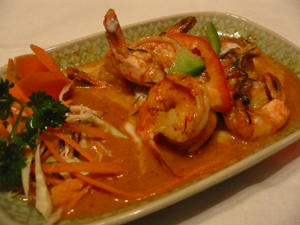
Thai Sea Food Blog : Ingredients:
- River shrimps 500 grams
- Coconut cream 1 cup
- Coconut milk 2 cups
- Fish sauce 3 tablespoons
- Cut sugar 2 tablespoons
- Kaffir lime leaves, finely sliced 1 tablespoon
- Vegetable oil 2 tablespoons
Thai Sea Food Blog : Curry Paste
Ingredients:
- Big dried chilies(seeds removed and soaked in water) 5 each
- Shallots, sliced 5 tablespoons
- Garlic, chopped 2 tablespoons
- Galangal, finely sliced 1 teaspoon
- Kaffir lime peel, finely sliced 1/2 teaspoon
- Coriander roots, finely sliced 1 teaspoon
- Salt 1 teaspoon
- Shrimp paste (Kapi) 1 teaspoon
Thai Sea Food Blog : Directions:
1. Remove the shells and heads of the shrimps, and scald the shrimps in boiling water until they become 70% cooked.
2. Grind dried chilies and salt until delicate, add galangal, kaffir lime peel and coriander roots, and grind all until delicate. Add shrimp paste and grind until the mixture is well-blended.
3. Pour oil in a wok on a medium heat. Add chili paste. Lower the heat and fry until fragrant. Pour 1 cup of coconut cream into the mixture, fry until the mixture is fragrant and oil patches float on the surface. Add coconut milk and spoon onto a pot on a heat and bring to boil. Add shrimps and correct seasoning with fish sauce and sugar for the tastes of saltiness and mild sweetness. Top with kaffir lime leaves before serving.
Correct Characteristics of Chuchee:
- The curry must be orange and red in color as no spice is used in this dish.
- The curry must have a strong aroma of kaffir lime peel.
- The curry must taste sweet from coconut milk and little creamy but not spicy.
Cooking Tips:
- Cook chuchee paste in cooking oil until fragrant before adding coconut milk little by little, and continue cooking on low heat.
- If fish is used, choose only fillets and fry them for a while so the texture will not be mushy when cooked in the soup.
- In case of Chuchee Kung (shrimps) and Chuchee Pla (fish), shrimps and fish must be cooked in soup long enough to absorb the soup. Shrimps must be scalded first to prevent fishy smell and rubbery texture.
Eating Culture:
1. Thai food is eaten family style, where all kinds of dishes including soups, curries etc. are placed in the middle of a dining table and served with serving spoons. Each person is given a plate of rice and all can choose what to eat with rice according to their taste. According to the Thai traditional style, Chuchee can be eaten either with the main meal with rice rather than the first course.
2. To make it Western eating style, Chuchee can be served with bread or pasta such as spaghetti and macaroni.
3. At all times, Chuchee should be served warm.
How to Serve:
- Put Chuchee in serving boils and top with kaffir lime leaves. Serve as a dish with the main meal in the middle of a dining table for eating with rice.
Recipe Variations:
If desired, fish can be used in place of shrimps. Chuchee can also be eaten with bread or put on top of pasta.
Name Derivative : Chuchee is the sound of frying chili paste with shrimps or fish.
Nutritional and Medicinal Properties of Herbs used in Chuchee:
Kaffir Lime Leaves or Bai Ma Krood (in Thai):
Kaffir lime leaf is a major ingredient of Tom Yam, Tam Kha, and all kinds of Thai curry which gives good aroma of Thai cooking.
It aids digestion and relieves stomachache.
Chili Peppers or Prik Kee Nu (in Thai):
These small fresh Thai chili peppers whose essential oil and flavors give the characteristic hot taste and aroma of Thai cooking. It is the star ingredient of most dishes. Almost any dish will taste better with a small addition of these tiny hot peppers. Tom Yam and Tom Kha cannot be made without them.
This kind of herb relieves diarrhea, stimulates digestion, the heat increases blood flow to taste buds and thus increases appetite, relieves infection, dissolves blood clot and prevents intestinal cancer.
Shallots (Hom Lek or Hom Daeng (in Thai)) :
It gives sweet flavor and scent to the soup or stock.
It aids digestion, relives cold symptoms, increases appetite, and regulates menstruation.
Ka (Mature Galangal)
Use : Beef and chicken tomyams need mature galangal root to improve the flavor of the beef and chicken. The dishes will have a better aroma and taste.
Medicinal properties : Relieves skin rash, diarrheas, indigestion and body pain due to crash and fall.
Gratiem (Garlic)
Use : Almost all-Thai dishes contain garlic, in soups, curries, salads, sauces and pan-fried dishes.
Medicinal properties : Cures and prevent atherosclerosis, high blood pressure, aids digestion, relieves cold symptoms, and fights some intestinal parasites.
Coriander Roots (Cilantro Roots) or Rak Pak Chee (in Thai):
Coriander root is an important ingredient in soup and curry mixtures. It is also used in stewing soup stocks and most meat preparation.
It aids digestion, prevents constipation, cures scurry, pellagra and beriberi, increases appetite and relieves cold symptoms.
No comments:
Post a Comment